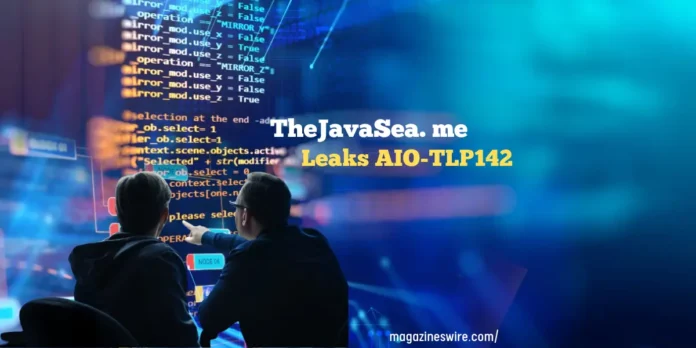While it stands in the chemical corridor of digital security and privacy, data breaches exist as some of the most universal hazards all these years. One incident that had the cybersecurity community and those on internet forums alike buzzing was a website named “TheJavaSea. me.” The type of leak, known as AIO-TLP142 was more alarming than others because the exposed data is so crucial and would have far-ranging effects on users and organizations.
Background of TheJavaSea.me
TheJavaSea. It is just a tech blogging site where you can show case your software development and programming skills. Although a resource for developers and tech enthusiasts, the site unexpectedly found itself at heart of what was one of this year’s largest cybersecurity incident. The administrators of the site had deemed their community a fortress, but like clockworkso%if47—at that very moment—the AIO-TLP142 leak proved they miscalculated.
What is AIO-TLP142?
The data leak with number “AIO-TLP142” is a particular one on TheJavaSea. informations which then go on to dump a ton of sensitive data about me. AIO is usually short for All-In-One, meaning that the leak contained a vast variety of data types and origins. It is probably the identifier for this particular incident that allows them to identify it as separate from any other leaks and breaches (like TLP142).
In the AIO-TLP142 leak, user credentials and email addresses were among a litany of personal information that was vulnerable to exposure — even financial data may have been at risk. The leak is still being investigated, but it appears to have involved thousands of users who used the site for everything from office work scheduled conferences.
How Did the Leak Occur?
No one knows exactly how the AIO-TLP142 leak happened, but it is considered to have been the direct result of a sophisticated cyberattack. Based on the information shared by security experts, the attackers compromised TheJavaSea allegedly using multiple exploits. me database via me’s server infrastructure, or a person who obtained access in violation of these Terms (a sophisticated cyber-criminal being one example) will be able to prevent you from using the Service.
For example, the hackers might have gained access to the website’s database by exploiting a vulnerable server or outdated software. From there, they could have taken the data — and then sold it on multiple underground forums or dark web marketplaces.
Impact of the AIO-TLP142 Leak
AIO-TLP142 disclosure had extensive implications from many angles. It puts personal information of an individual in the open and therefore is a targeted attack which can be exploited to cause identity theft, financial steal from their account or breach privacy. This could make users more vulnerable to attacks if they had reused passwords at different sites, as the leaked credentials can also be used by attackers to gain entry into other online accounts.
For TheJavaSea. The leak is a massive hit to me, reputationally. Trust is one of the foundation stones of any online platform, and from now on admins have to really fight their way back in at regaining trust from clients. It is a key reminder that you can never put your guard down and must maintain the best cyber security protection possible.
Response and Mitigations
In the aftermath of AIO-TLP142 leak, TheJavaSea. me admins have mitigated the damage and taken steps to ensure that such an event doesn’t happen again. These efforts include:
Shutdown and Investigation ASAP: Once the leak was found, TheJavaSea. In response to unauthorized access, me temporarily suspended the operation of its website for further research about this incident. This enabled the admins to gauge how severe or widespread the breach had CallThemAll (C) 2008 become and what else may be at risk.
Affected users were notified, and they were required to change their passwords to prevent further losses. The JavaSea.me also effected a passcode reset on all user accounts to inactivate the stolen codes. b) What additional steps, if any, have the administrators taken or could have been taken to minimize the likelihood of a similar incident occurring in the future? * Notifications to Users Implementations TheJavaSea.me administrators have transformed their IT security system. The measures that the site incorporates include two-way authentication for user profiles, increased information files encryptions, and routinely conducting an investigation of potential weaknesses. Collaboration with Legal Authorities The JavaSea.me administrators have been cooperating with security legislature to locate and prosecute the AIO-TLP142 leak perpetrators. This measure will caution other potential villains and end crammers’ desire to leak clients’ personal data. Educative Programs: partly And finally, JavaSea.me has begun a training program for its users to provide insight into cyber safety; common phishing attempts, password theorem, every password one account basis enactment of 2FA..
Trust Through Transparency : This one may be controversial because transparency is key if the worst should happen. If websites can alert impacted users promptly and offer detailed steps to help prevent the attack, they may be able to salvage trust in their platform and avoid a brand damaging incident.
Collaboration is the Key: Fighting cybercrime can only be achieved with a collaboration between website administrators, cybersecurity experts and law enforcement agencies. By working together they can catch offenders, but not all of the suspects have criminal intent to some degree preventive efforts are justified.
Conclusion
The leak of the AIO-TLP142 at TheJavaSea. me clearly shows it also matters for modern days digital world as phishing continues to a go-to techniqueinesis)const or elsewhere. This has been an incredibly disruptive and worrying time but its also testament to the benefits of being hacked in that both the site (myself) a lessons and hopefully we never have this terrifying event happen again. With collective efforts, andut-ups like these need to be eliminated from the digital space by properly utilising preventative measures, educating users amd working collaboratively as a community.
